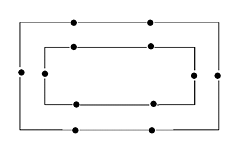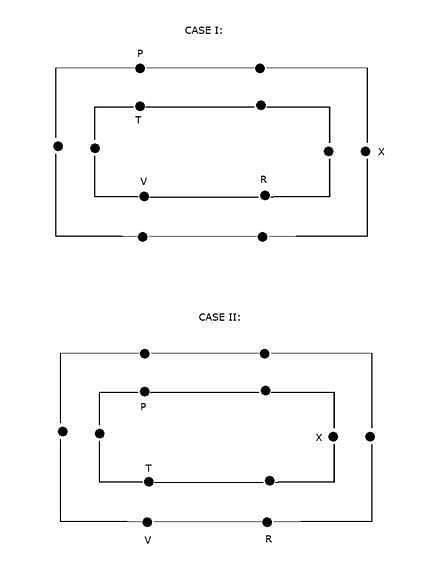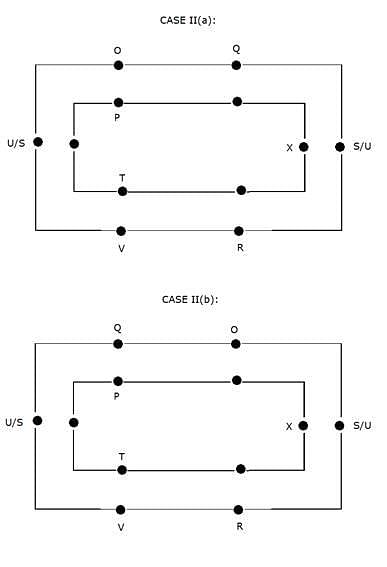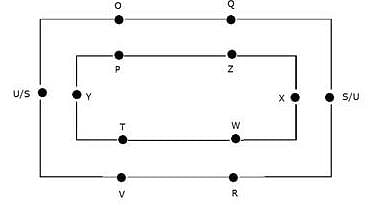Banking Exams Exam > Banking Exams Questions > Directions [Set of 4 questions]: A small rect...
Start Learning for Free
Directions [Set of 4 questions]: A small rectangular slab is kept above a large rectangular slab such that their centres coincide with each other. Twelve points are marked on the edges of the slabs, six on each slab, such that, the longer sides of both the slabs have two points each, and the shorter side has one point each. Each point of one slab is in same line of sight on other slab. Also, point marked in between two points is to be considered in the same line of sight. (to the right of any point - anticlockwise, to the left of any point - clockwise)
- V is marked to immediate left of R.
- T is marked in between V and P, which is marked second to right of X.
- O and Q are marked on the longer side of same slab.
- T and X, are marked on the same slab.
- Y is not marked at any point immediately left/right of X.
- U and S are maximum possible distance apart.
- O is not marked in front of either Z or W.
- Z is not marked in front of R.
Q. Which point is marked to immediate right of R?
- a)S
- b)X
- c)U
- d)P
- e)Either (a) or (c)
Correct answer is option 'E'. Can you explain this answer?
Most Upvoted Answer
Directions [Set of 4 questions]: A small rectangular slab is kept abov...
The given arrangement makes a concentric rectangular arrangement shown as follow

It is given,

It is given,
- V is marked to immediate left of R.
- T is marked in between V and P, which is marked second to right of X.
So, we get two cases, either V and R can be on small slab or on large one.

Now,
Since, T and X are marked on the same slab.
So, case I becomes invalid.
But,
We are given that,

Now,
Since, T and X are marked on the same slab.
So, case I becomes invalid.
But,
We are given that,
- O and Q are marked on the longer side of same slab.
- U and S are maximum possible distance apart.
i.e., U and S have two points in between them, and are on shorter sides, of larger slab.
This gives us two subcases as follows, from case II.

This gives us two subcases as follows, from case II.

- Y is not marked at any point immediately left/right of X.
- O is not marked in front of either Z or W, so, case II(b) becomes invalid and the final arrangement is as follow:
Also,
Z is not marked in front of R.
We get,

Either S or U is to immediate right of R.

Either S or U is to immediate right of R.

|
Explore Courses for Banking Exams exam
|

|
Directions [Set of 4 questions]: A small rectangular slab is kept above a large rectangular slab such that their centres coincide with each other. Twelve points are marked on the edges of the slabs, six on each slab, such that, the longer sides of both the slabs have two points each, and the shorter side has one point each. Each point of one slab is in same line of sight on other slab. Also, point marked in between two points is to be considered in the same line of sight. (to the right of any point - anticlockwise, to the left of any point - clockwise) V is marked to immediate left of R. T is marked in between V and P, which is marked second to right of X. O and Q are marked on the longer side of same slab. T and X, are marked on the same slab. Y is not marked at any point immediately left/right of X. U and S are maximum possible distance apart. O is not marked in front of either Z or W. Z is not marked in front of R.Q. Which point is marked to immediate right of R?a)Sb)Xc)Ud)Pe)Either (a) or (c)Correct answer is option 'E'. Can you explain this answer?
Question Description
Directions [Set of 4 questions]: A small rectangular slab is kept above a large rectangular slab such that their centres coincide with each other. Twelve points are marked on the edges of the slabs, six on each slab, such that, the longer sides of both the slabs have two points each, and the shorter side has one point each. Each point of one slab is in same line of sight on other slab. Also, point marked in between two points is to be considered in the same line of sight. (to the right of any point - anticlockwise, to the left of any point - clockwise) V is marked to immediate left of R. T is marked in between V and P, which is marked second to right of X. O and Q are marked on the longer side of same slab. T and X, are marked on the same slab. Y is not marked at any point immediately left/right of X. U and S are maximum possible distance apart. O is not marked in front of either Z or W. Z is not marked in front of R.Q. Which point is marked to immediate right of R?a)Sb)Xc)Ud)Pe)Either (a) or (c)Correct answer is option 'E'. Can you explain this answer? for Banking Exams 2025 is part of Banking Exams preparation. The Question and answers have been prepared according to the Banking Exams exam syllabus. Information about Directions [Set of 4 questions]: A small rectangular slab is kept above a large rectangular slab such that their centres coincide with each other. Twelve points are marked on the edges of the slabs, six on each slab, such that, the longer sides of both the slabs have two points each, and the shorter side has one point each. Each point of one slab is in same line of sight on other slab. Also, point marked in between two points is to be considered in the same line of sight. (to the right of any point - anticlockwise, to the left of any point - clockwise) V is marked to immediate left of R. T is marked in between V and P, which is marked second to right of X. O and Q are marked on the longer side of same slab. T and X, are marked on the same slab. Y is not marked at any point immediately left/right of X. U and S are maximum possible distance apart. O is not marked in front of either Z or W. Z is not marked in front of R.Q. Which point is marked to immediate right of R?a)Sb)Xc)Ud)Pe)Either (a) or (c)Correct answer is option 'E'. Can you explain this answer? covers all topics & solutions for Banking Exams 2025 Exam. Find important definitions, questions, meanings, examples, exercises and tests below for Directions [Set of 4 questions]: A small rectangular slab is kept above a large rectangular slab such that their centres coincide with each other. Twelve points are marked on the edges of the slabs, six on each slab, such that, the longer sides of both the slabs have two points each, and the shorter side has one point each. Each point of one slab is in same line of sight on other slab. Also, point marked in between two points is to be considered in the same line of sight. (to the right of any point - anticlockwise, to the left of any point - clockwise) V is marked to immediate left of R. T is marked in between V and P, which is marked second to right of X. O and Q are marked on the longer side of same slab. T and X, are marked on the same slab. Y is not marked at any point immediately left/right of X. U and S are maximum possible distance apart. O is not marked in front of either Z or W. Z is not marked in front of R.Q. Which point is marked to immediate right of R?a)Sb)Xc)Ud)Pe)Either (a) or (c)Correct answer is option 'E'. Can you explain this answer?.
Directions [Set of 4 questions]: A small rectangular slab is kept above a large rectangular slab such that their centres coincide with each other. Twelve points are marked on the edges of the slabs, six on each slab, such that, the longer sides of both the slabs have two points each, and the shorter side has one point each. Each point of one slab is in same line of sight on other slab. Also, point marked in between two points is to be considered in the same line of sight. (to the right of any point - anticlockwise, to the left of any point - clockwise) V is marked to immediate left of R. T is marked in between V and P, which is marked second to right of X. O and Q are marked on the longer side of same slab. T and X, are marked on the same slab. Y is not marked at any point immediately left/right of X. U and S are maximum possible distance apart. O is not marked in front of either Z or W. Z is not marked in front of R.Q. Which point is marked to immediate right of R?a)Sb)Xc)Ud)Pe)Either (a) or (c)Correct answer is option 'E'. Can you explain this answer? for Banking Exams 2025 is part of Banking Exams preparation. The Question and answers have been prepared according to the Banking Exams exam syllabus. Information about Directions [Set of 4 questions]: A small rectangular slab is kept above a large rectangular slab such that their centres coincide with each other. Twelve points are marked on the edges of the slabs, six on each slab, such that, the longer sides of both the slabs have two points each, and the shorter side has one point each. Each point of one slab is in same line of sight on other slab. Also, point marked in between two points is to be considered in the same line of sight. (to the right of any point - anticlockwise, to the left of any point - clockwise) V is marked to immediate left of R. T is marked in between V and P, which is marked second to right of X. O and Q are marked on the longer side of same slab. T and X, are marked on the same slab. Y is not marked at any point immediately left/right of X. U and S are maximum possible distance apart. O is not marked in front of either Z or W. Z is not marked in front of R.Q. Which point is marked to immediate right of R?a)Sb)Xc)Ud)Pe)Either (a) or (c)Correct answer is option 'E'. Can you explain this answer? covers all topics & solutions for Banking Exams 2025 Exam. Find important definitions, questions, meanings, examples, exercises and tests below for Directions [Set of 4 questions]: A small rectangular slab is kept above a large rectangular slab such that their centres coincide with each other. Twelve points are marked on the edges of the slabs, six on each slab, such that, the longer sides of both the slabs have two points each, and the shorter side has one point each. Each point of one slab is in same line of sight on other slab. Also, point marked in between two points is to be considered in the same line of sight. (to the right of any point - anticlockwise, to the left of any point - clockwise) V is marked to immediate left of R. T is marked in between V and P, which is marked second to right of X. O and Q are marked on the longer side of same slab. T and X, are marked on the same slab. Y is not marked at any point immediately left/right of X. U and S are maximum possible distance apart. O is not marked in front of either Z or W. Z is not marked in front of R.Q. Which point is marked to immediate right of R?a)Sb)Xc)Ud)Pe)Either (a) or (c)Correct answer is option 'E'. Can you explain this answer?.
Solutions for Directions [Set of 4 questions]: A small rectangular slab is kept above a large rectangular slab such that their centres coincide with each other. Twelve points are marked on the edges of the slabs, six on each slab, such that, the longer sides of both the slabs have two points each, and the shorter side has one point each. Each point of one slab is in same line of sight on other slab. Also, point marked in between two points is to be considered in the same line of sight. (to the right of any point - anticlockwise, to the left of any point - clockwise) V is marked to immediate left of R. T is marked in between V and P, which is marked second to right of X. O and Q are marked on the longer side of same slab. T and X, are marked on the same slab. Y is not marked at any point immediately left/right of X. U and S are maximum possible distance apart. O is not marked in front of either Z or W. Z is not marked in front of R.Q. Which point is marked to immediate right of R?a)Sb)Xc)Ud)Pe)Either (a) or (c)Correct answer is option 'E'. Can you explain this answer? in English & in Hindi are available as part of our courses for Banking Exams.
Download more important topics, notes, lectures and mock test series for Banking Exams Exam by signing up for free.
Here you can find the meaning of Directions [Set of 4 questions]: A small rectangular slab is kept above a large rectangular slab such that their centres coincide with each other. Twelve points are marked on the edges of the slabs, six on each slab, such that, the longer sides of both the slabs have two points each, and the shorter side has one point each. Each point of one slab is in same line of sight on other slab. Also, point marked in between two points is to be considered in the same line of sight. (to the right of any point - anticlockwise, to the left of any point - clockwise) V is marked to immediate left of R. T is marked in between V and P, which is marked second to right of X. O and Q are marked on the longer side of same slab. T and X, are marked on the same slab. Y is not marked at any point immediately left/right of X. U and S are maximum possible distance apart. O is not marked in front of either Z or W. Z is not marked in front of R.Q. Which point is marked to immediate right of R?a)Sb)Xc)Ud)Pe)Either (a) or (c)Correct answer is option 'E'. Can you explain this answer? defined & explained in the simplest way possible. Besides giving the explanation of
Directions [Set of 4 questions]: A small rectangular slab is kept above a large rectangular slab such that their centres coincide with each other. Twelve points are marked on the edges of the slabs, six on each slab, such that, the longer sides of both the slabs have two points each, and the shorter side has one point each. Each point of one slab is in same line of sight on other slab. Also, point marked in between two points is to be considered in the same line of sight. (to the right of any point - anticlockwise, to the left of any point - clockwise) V is marked to immediate left of R. T is marked in between V and P, which is marked second to right of X. O and Q are marked on the longer side of same slab. T and X, are marked on the same slab. Y is not marked at any point immediately left/right of X. U and S are maximum possible distance apart. O is not marked in front of either Z or W. Z is not marked in front of R.Q. Which point is marked to immediate right of R?a)Sb)Xc)Ud)Pe)Either (a) or (c)Correct answer is option 'E'. Can you explain this answer?, a detailed solution for Directions [Set of 4 questions]: A small rectangular slab is kept above a large rectangular slab such that their centres coincide with each other. Twelve points are marked on the edges of the slabs, six on each slab, such that, the longer sides of both the slabs have two points each, and the shorter side has one point each. Each point of one slab is in same line of sight on other slab. Also, point marked in between two points is to be considered in the same line of sight. (to the right of any point - anticlockwise, to the left of any point - clockwise) V is marked to immediate left of R. T is marked in between V and P, which is marked second to right of X. O and Q are marked on the longer side of same slab. T and X, are marked on the same slab. Y is not marked at any point immediately left/right of X. U and S are maximum possible distance apart. O is not marked in front of either Z or W. Z is not marked in front of R.Q. Which point is marked to immediate right of R?a)Sb)Xc)Ud)Pe)Either (a) or (c)Correct answer is option 'E'. Can you explain this answer? has been provided alongside types of Directions [Set of 4 questions]: A small rectangular slab is kept above a large rectangular slab such that their centres coincide with each other. Twelve points are marked on the edges of the slabs, six on each slab, such that, the longer sides of both the slabs have two points each, and the shorter side has one point each. Each point of one slab is in same line of sight on other slab. Also, point marked in between two points is to be considered in the same line of sight. (to the right of any point - anticlockwise, to the left of any point - clockwise) V is marked to immediate left of R. T is marked in between V and P, which is marked second to right of X. O and Q are marked on the longer side of same slab. T and X, are marked on the same slab. Y is not marked at any point immediately left/right of X. U and S are maximum possible distance apart. O is not marked in front of either Z or W. Z is not marked in front of R.Q. Which point is marked to immediate right of R?a)Sb)Xc)Ud)Pe)Either (a) or (c)Correct answer is option 'E'. Can you explain this answer? theory, EduRev gives you an
ample number of questions to practice Directions [Set of 4 questions]: A small rectangular slab is kept above a large rectangular slab such that their centres coincide with each other. Twelve points are marked on the edges of the slabs, six on each slab, such that, the longer sides of both the slabs have two points each, and the shorter side has one point each. Each point of one slab is in same line of sight on other slab. Also, point marked in between two points is to be considered in the same line of sight. (to the right of any point - anticlockwise, to the left of any point - clockwise) V is marked to immediate left of R. T is marked in between V and P, which is marked second to right of X. O and Q are marked on the longer side of same slab. T and X, are marked on the same slab. Y is not marked at any point immediately left/right of X. U and S are maximum possible distance apart. O is not marked in front of either Z or W. Z is not marked in front of R.Q. Which point is marked to immediate right of R?a)Sb)Xc)Ud)Pe)Either (a) or (c)Correct answer is option 'E'. Can you explain this answer? tests, examples and also practice Banking Exams tests.

|
Explore Courses for Banking Exams exam
|

|
Signup for Free!
Signup to see your scores go up within 7 days! Learn & Practice with 1000+ FREE Notes, Videos & Tests.
























